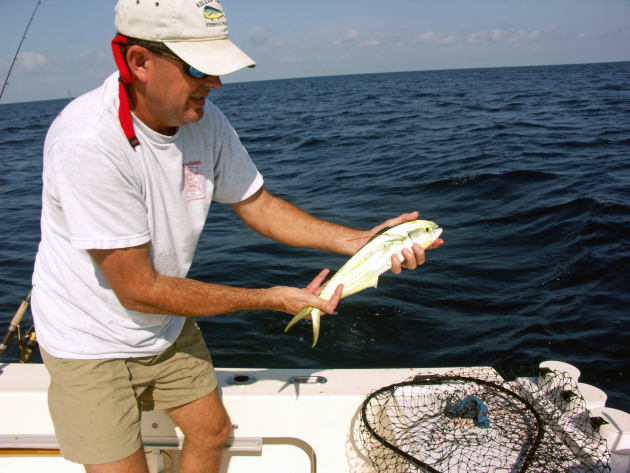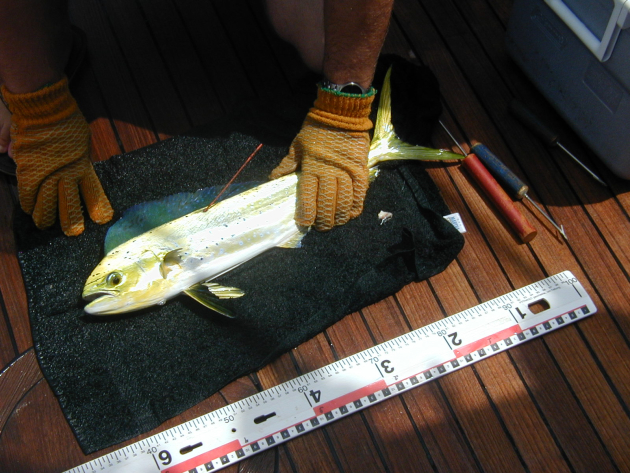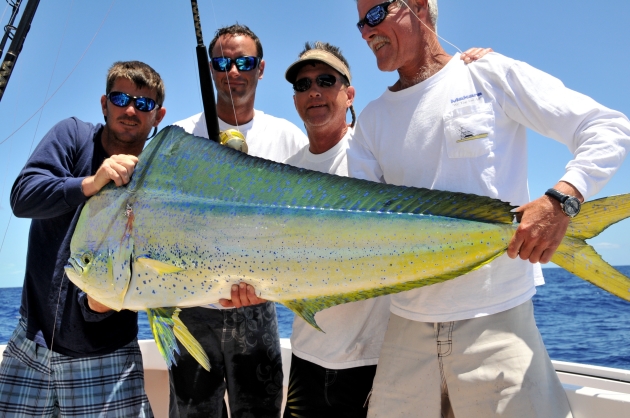Something very unusual—perhaps ominous—is happening with the dolphinfish population off the southeastern United States.
In a normal year hordes of young-of-year dolphin (mahi-mahi) cruise the offshore waters from Florida to the Mid-Atlantic states, but this year few YOY fish showed up and, in some areas, none were seen or caught. Dolphin are extremely fast-growing, and the YOY fish mature in one year into the “gaffer” fish sought by sport anglers and charter captains the following year.
The sharp decline in the number of young dolphin showing up along the southeastern coast has charter captains and scientists wondering if fishing for the highly prized sportfish will be boom or bust in 2017. Marine biologist Don Hammond, who has managed the Dolphinfish Research Program out of Charleston, South Carolina, for the past 15 years since retiring from the S.C. Department of Natural Resources, is concerned that 2017 may be the acid test for Atlantic mahi-mahi.
For Hammond, who tracks dolphin migrations with a tagging program through the cooperation of charter captains from the Atlantic Coast into the Caribbean, there are three burning questions:
- Where were the YOY dolphinfish this year?
- Will there be a successful fishing season for the highly prized sportfish in 2017?
- If there was a sudden population decline, what caused it?
As for No. 1, Hammond is hopeful the lack of YOY fish this year was something as simple as a slight shift in migratory patterns. The answer to No. 2 lies somewhere between No. 1 and No. 3. Hammond is fearful that the answer to No. 3 may turn out to be that something deadly serious has happened to dolphinfish reproduction and survival.
He fears some catastrophic event has killed almost an entire year class of fish, and it may be devastating to dolphin fishing in 2017. He pointed to the latent effects of the worst oil disaster in U.S. history—the 2010 Deep Water Horizon explosion, which spilled more than three million barrels of crude oil into the northern Gulf of Mexico, contaminating the spawning habitats for many fishes, including dolphin.

Scientists work to identify what’s causing Young-of-Year (YOY) dolphin to fall ill.
Both the crude oil and the dispersant used to dilute it have been proven to be toxic to fish, he said. A study by scientists at the University of California Riverside and the University of Miami Rosenstiel School of Marine and Atmospheric Science found that ultraviolet light increases the toxicity of the oil and damages the heart, eye, and neurological functions of fish larvae.
“Ours is the first experiment evaluating the effects of DWH oil on the genetic responses of mahi-mahi embryos and larvae,” said Daniel Schlenk, a professor of aquatic ecotoxicology at UCR, who led the study, published in Environmental Science and Technology. “It is also the first experiment of this nature on a lifestage and species that was likely exposed to the oil. We found that the weathering of oil had more significant changes in gene expression related to critical functions in the embryos and larvae than the un-weathered oil. Our results predict that there are multiple targets of oil for toxicity to this species at the embryonic life stage.”
For their experiments, Schlenk and UM Rosenstiel School scientists caught the mahi-mahi off the coast of Miami, Florida, and exposed embryos to two types of oil: one set of embryos was exposed to slick oil (weathered) from the spill, while another set was exposed to oil that came from the source of the spill.
The researchers carried out the experiment this way because fish in the northern Gulf of Mexico had been exposed during the spill to both types of oil. Their study attempted to understand which of the two oils—slick oil or source oil—is worse for the fish and how oil affects development.
Schlenk said his team found that not only was the heart of the fish the target, but also that the general neurological function was likely to be impaired, as well as the cardiovascular system. It also affected the sensory function, which is important for prey detection and predator avoidance.
The research was funded by the Gulf of Mexico Research Initiative, as well as the Relationship of Effects of Cardiac Outcomes in fish for Validation of Ecological Risk (RECOVER) consortium. Shortly after the Deepwater Horizon Oil Spill, BP announced a commitment of up to $500 million over ten years to fund research to study the impact of the oil spill and its associated response on the environment and public health in the Gulf of Mexico.
Schlenk’s dolphin study is one of a number of scientific research programs funded by the GMRI. Whether the toxic effects of the oil has changed the normal movements of the fish or made them more susceptible to predation and other factors could be discovered in the next phase of the study. That part, he said, will be a population study to determine how the fish respond in terms of movement.
“We hope to treat animals in the lab and release them with tags to see if that is something that impairs their movement. When you expose them at a larval stage and they survive, does that make them less able to survive in the wild?”
Ironically, Hammond said the 2016 spring dolphin fishing season along the U.S. East Coast arrived early and featured some excellent fishing for 15- to 25-pound fish, but was rather abbreviated except off North Carolina. But in the October DRP Newsletter, he wrote: “The scary part of the 2016 season was that the young-of-year (YOY) school fish did not show up in good numbers after the gaffer dolphin had left.”

Careful scientific research may lead to the cause of the dolphin’s absence, but the effects will likely be difficult to combat.
Hammond explained that normally the YOY fish flood into the area after the larger dolphin have left. Large schools of the voracious little fish provide fun and excitement for anglers and sustain charter boat fishing from southeastern Florida to the Outer Banks of North Carolina throughout the summer.
His concern is backed up by the experiences this year of charter boats on the southeastern coast.
“Our dolphin fishing out of Charleston this year was almost all gaffers,” said Capt. Bobby Krivohlavek, who fishes The Day Maker out of Charleston’s Shem Creek. “We did not have a lot of small ones, and I don’t know if it was a lack of small dolphins or if they were just not where we were fishing.”
Krivohlavek said he did find plenty of small dolphins off Oregon Inlet in North Carolina and Virginia Beach. But, he added, many of the dolphins he caught this year were not healthy fish.
“Our biggest concern this year was we were catching a lot of dolphin that were sickly and had a lot of parasites in them. They were unhealthy looking fish, skinny with red eyes. That is the first time we’ve caught that many unhealthy fish.”
Capt. Rom Whitaker, who fishes The Release out of Hatteras Village, North Carolina, said he has not seen many small dolphin off Hatteras for the past two years.
“Normally, June, July, and August is when we catch ‘bailer’ fish, but our good ‘bailer’ fishing came late last year—September and October. This year, although I won’t say it is nonexistent, it is really slow.”
Hammond said the best-case scenario would be that the low numbers are the result of some subtle change in North Atlantic ocean currents that threw the YOY migration off this year, and there could be a return of strong numbers of gaffer fish and YOY dolphin next year.
“With dolphinfish, as with other highly migratory species, there is a large part of their life that we know little about. We know that these fish utilize and even circumnavigate the Sargasso Sea, riding the ocean’s many currents as far south as the Caribbean Sea. This migratory route encompasses a vast area that could harbor large numbers of dolphinfish that would normally have traveled to the U.S. coasts but for some reason did not,” he said.
“We don’t know anything about them in the 6,000-mile trip they make each year in the open Atlantic Ocean and the Sargasso Sea. There could be a phenomenal population of fish out in that area that we don’t know about, and we could wind up having a banner season next year.”
If not, the result could be a major blow to the coastal economy of both states, Hammond said.
“My work shows that offshore anglers fish far more when the dolphin are biting. Each year when the dolphin disappear, offshore anglers stop or radically reduce the number of fishing trips. Without the spring dolphin run, there could be a major economic loss to the coastal economy.”
“The dolphin are our bread and butter,” said Capt. Whitaker. “From May to September it is our No. 1 caught fish. It concerns me when we don’t see them.”

